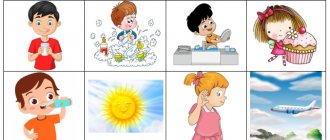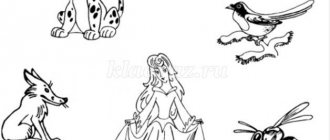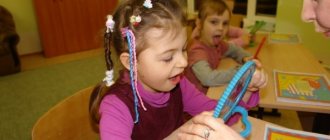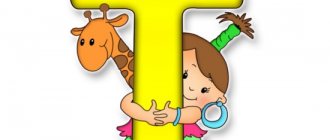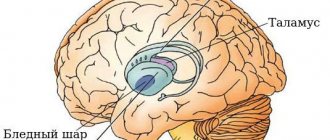Article:
OBJECTIVES: 1. Clarify the pronunciation of the existing sound “SH”.
Achieve correct pronunciation of the isolated sound “Ш”. Learn to determine the position of the lips and tongue when pronouncing the sound “Ш” 2. Automate the sound in speech. Teach the child to correctly pronounce and articulate this sound in straight syllables, in words with straight syllables with stress on the syllable, in poetry and in phrasal speech. 3. Development of phonemic awareness. Distinguishing the sound “Ш” in a series of sounds. The ability to hear and identify sounds in words. 4. Development of memory, auditory attention: bringing linear memory to 4 units. Learn to memorize words in a given order. 5. Development of fine motor skills of the hands by influencing the active points of the palms with a su-jok ball. VISUAL MATERIAL. 1. Toys whose names contain the sound “SH” (cat...). 2. Subject pictures: hat, cat, T-shirt, washer, shampoo, towel, fur coat, pipe, car, basket.
PROGRESS OF THE LESSON 1. Organizational moment Show the child a toy (cat). The word cat has the sound "sh". - We will learn to pronounce this sound correctly. Hiss like a cat: Sh-Sh-Sh... Show the child a toy (snake). Let's sing the snake song. Say the sound “Sh” for a long time with one exhalation: Sh-Sh-Sh...
Clarify the articulatory structure. - Let's remember where the sound “Ш” lives, the tongue at the top, resembles a “cup shape”. The lips are rounded and slightly pushed forward, the teeth are close together but do not touch, the tip of the tongue is wide, raised to the palate (behind the alveoli), but does not touch it, forming a gap. The lateral edges are pressed from the inside to the upper molars, not allowing a stream of exhaled air to pass along the sides.
2. Syllable warm-up. - Let's play, I tell you the syllables, and you clearly repeat after me: Sha-sha-sha Shi-shi-shi Asha-asha-asha Ashi-ashi-ashi Sho-sho-sho Shu-shu-shu Asho-asho- asho Ashu-ashu-ashu She-she-she She-ashe-ashe
3. Automation in words with straight syllables, with emphasis on the syllable with the sound “Ш”. - Now, let's sing a song: sha-sha-hat sha-sha-puck sha-sha-chess sha-sha-shampoo sha-sha-mine sha-sha-step sha-sha-champignon sha-sha-stir sha- sha-ushanka sha-sha-breathe sha-sha-decide sha-sha-horse sho-sho-seam sho-sho-whisper sho-sho-bag sho-sho-fluff sho-sho-pot sho-sho-top sho- sho-cock sho-strap sho-sho-mouse
Shu-shu-noise Shu-shu-joke Shu-shu-joke Shu-shu-joking Shu-shu-skimmer Shu-shu-joker Shu-shu-fur coat Shu-shu-make noise shi-shi-screen shi-shi-jug shi-shi-car She-she-neck She-she-whisper She-she-target She-she-whisper She-she-breathe She-she-beg She-she-carry shi-shi-tire ashi-shi-spikes shi-shi-sew shi-shi-thorn shi-shi-sewing shi-shi-sizzle shi-shi-rosehip shi-shi-shilo
4. Automation of the sound “Ш” in phrasal speech. - Let's play the game "Parrot." I say a phrase, and you repeat after me. Dasha has chess. Masha eats stew. Yasha has millet porridge. Yasha's car has tires. Natasha hangs her fur coat in the closet. The cat has ears on the top of its head. Pasha rolls a bear on a car. Chess and checkers are in Dasha's closet. The naughty ones were making noise and playing pranks. Someone hisses under the rose hips. It is convenient to remove the champignons with a slotted spoon. The minx tore her shorts. Shura has wide trousers. The driver needs to check the tires. Miners extract coal at the mine.
5. Finger gymnast. A poem using Su-jok technology. - Now listen to the new poem “Our Masha” Our Masha got up early, counted all the dolls: Two nesting dolls on the window, Two Tanya on the pillow. - Take a magic ball, roll it between your palms and pronounce this poem with me clearly and correctly.
Development of phonemic awareness and auditory attention. (Working with an object picture). (Words with the sound “Ш” in different positions). - Look at the pictures and name what is shown there. “Now I’ll name the words, you clap your hands if you hear the sound “SH.” Pictures: hat, cat, T-shirt, washer, shampoo, towel, fur coat, pipe.
6. Development of memory, auditory attention. “And now I’ll tell you a few words in a row, and you try to remember them and repeat them, be careful!” Noise-joke-fur-cat
7. Summary of the lesson. “You’ve done well today, and you’ve learned to pronounce the sound “Sh” clearly and correctly.” You worked hard and deserve a sticker as a reward! Homework: learn the poem “Our Masha.”
Summary of individual speech therapy sessions. Automation of sound Ш
Summary of an individual speech therapy lesson on sound automation [Ш] for a child 5-6 years old
Author: Ponomareva Tatyana Aleksandrovna, teacher-speech therapist of the Municipal Preschool Educational Institution "Kindergarten No. 166 "Swallow", Saratov
Synopsis of an individual speech therapy lesson on sound automation [Ш] "Road" for Masha"
Description of the material: I offer you a summary of a lesson on sound automation [Ш] for children of senior preschool age (5-6 years old). This material will be useful to kindergarten speech therapists. This summary is for the stage of sound automation in syllables, words, sentences and poems. Form of delivery: individual lesson. Equipment: Masha doll, box, object pictures with sound [Ш], pictures with tasks, illustrations for poems. Goal: automation of sound [Ш] Objectives: a) correctional: to develop clear and differentiated movements of the articulatory apparatus; learn to pronounce the sound [Ш] in isolation, in syllables, words, sentences, poems; clarify the acoustic and pronunciation image of the sound [Ш], b) developmental: develop phonemic processes, memory, attention, motor skills; improve lexical and grammatical categories; c) educational: to cultivate a desire to help a friend, a desire to speak beautifully and correctly, and to create positive motivation in class. Progress of the lesson: I. Organizational moment. — On the way here I met the doll Masha. She forgot the way home. Let's take her home to her mom? Okay, I just know which path we need to take. And to make it more fun, we will perform different tasks along the way. II. Main part. 1. Articulation gymnastics. - Let's teach Masha to do the following exercises: “Fence/Tube” - 5 times. “Delicious jam” - 5 times. “Swing” - 10 times. “Cup” - 10 seconds. “Mushroom” - 5 seconds. “Horse” - 5 times. 2. Repetition of articulation of sound [Ш]
- Look, it’s crawling along the path and hissing! Let's hiss just like him. Now move your finger along the path and hiss. Now move your pencil and don’t forget to hiss like a snake. — Tell Masha how we pronounce the sound [Ш]. What do our tongue, lips, teeth do when pronouncing the sound [Ш]? (lips are rounded, teeth are closed with a small gap, the tongue looks like a “cup” and is raised by the tubercles behind the upper teeth). 3. Automation of sound in syllables. - Look, there are footprints on this path. Let's read what it says there. Shi-shu-sho Sha-she-shu Shu-sho-sha Shto-shty-shta Shto-shtu-shta Shko-shtu-shku Shko-shko-shku Shwe-shva-schvu Shwe-shty-shta 4. Finger gymnastics. “Little Frog” I will connect the ring finger, the middle one, with the big one. I’ll bend the other two back and show Little Frog. 5. Automation of sound in words. a) “Name the word and determine the place of the sound.”
- What is this box on the path?
Look what's in it. - Name the words and arrange the pictures accordingly: with the sound [Ш] at the beginning of the word, in the middle and at the end of the word. (Subject pictures: fur coat, chamomile, scarf, shirt, shower, wardrobe, cat, mouse, reeds, chess). b) “Count.”
-Who is that sleeping in the clearing? (Cat). Who does a cat see in her dream? (Mice). Count how many mice the cat saw in her dream. (One mouse, two mice, three mice...)
6. Automation of sound in sentences. - Match the action words with suitable pictures. Make up and speak sentences. Let's find out what Masha did. (Masha ate a chocolate bar. Masha ate a pear. Masha ate a cherry. Masha washed a pear. Masha saw a school. Masha went up to the school. Masha was embroidering a pillow. Masha bought a chocolate bar. Masha was hemming her shorts. Masha was ironing her shorts.)
7. Automation of sound in poems.
The cockerel found the bag. And there was a pot in the bag. And in the pot there are peas and a few crumbs.
Reeds rustled in the darkness. The cat thought it was a mouse. She ran into the reeds - There is not a soul in the reeds. III. Summarizing. “But I can see whose house is hidden behind the reeds.” Here we are. Masha says thank you. You took her home and taught her to pronounce the sound [Ш]. How do we pronounce the sound [Ш]? Remember who we met along the way? Well done! Today you tried and pronounced the sound correctly and helped the doll Masha find her way home.
We recommend watching:
Summary of educational activities in a compensatory preparatory group for children with severe speech impairments. Summary of individual lessons in a secondary speech therapy group on the topic “Automation of sound C.” Summary of educational activities in a senior compensatory group for children with severe speech impairments. 3 Summary of individual speech therapy sessions. Automation of sound L
Similar articles:
Lesson notes for a senior speech therapy group. Sound K
Summary of a speech therapy session with primary school children diagnosed with ODD
Summary of GCD for children of the senior speech therapy group
Summary of a speech therapy session with children 5-6 years old with mental retardation
Summary of educational activities in the older group of children with severe speech impairments on the topic: “Sounds S - Z”
MAGAZINE Preschooler.RF
Summary of an individual speech therapy lesson on sound automation [Ш] in syllables and words.The goal is to automate the sound [sh] in syllables, in words.
Tasks:
Educational
- Learn to maintain the articulatory posture of sound.
- Develop motor skills of the articulatory apparatus.
- Teach targeted air flow.
- Improve the skill of using nouns in Gen. case in singular and plural.
Correctional and developmental
- Develop phonemic awareness.
- Develop fine motor skills.
- Develop visual memory.
- Develop logical thinking.
Educational
- Cultivate interest in the activity.
- Cultivate responsiveness.
Equipment: Masha and Bear made of paper, a symbol for the sound Ш, a picture of Masha and the Bear, an envelope, a finger pool, blue balls, a rug, a soccer ball, butterflies, object pictures, an arrow.
Progress of the lesson
Organizing time
Riddle about the Bear:
L.: He sleeps in a den in winter under a huge pine tree, and when spring comes, he wakes up from sleep.
L.: Do you know the fairy tale “Masha and the Bear” ? The speech therapist shows a picture.
Masha and the Bear love to play hide and seek. Masha hid, but left hints for Mishka. Shall we help him find Masha?
Main part
Articulation gymnastics
L.: Mishka decided to see if Masha was hiding behind the mirror, but before that he looked in the mirror and smiled ( “Smile” ), then took a pipe and began to play it ( “Proboscis” ). He smiled and played the pipe ( “Smile-Proboscis” ). Then I looked out the window, the weather was good. ( "Window" ). He smiled and looked out the window. The weather was so good that he went to the swing. ( "Swing" ). And I rode down the hill ( “Gorka” ). I took a walk and went home to knead the dough ( "Knead the dough" ) and bake pancakes ( "Bake pancakes" ). Let's look at the finished pancakes ( "Pancakes" ). Let's blow on the pancake. The bear poured tea into a cup ( “Cup” ). The tea was hot, and Mishka began to drink from a straw ( “Strubochka” ). Breakfast is over, let's see, together with Misha, behind the screen. Have you seen Masha? Look, there is an envelope (with the sound symbol Ш inside). Masha wants us to teach the bear how to pronounce the sound SH correctly. Shall we help?
Repetition of the correct articulation of the sound Ш
L.: Let’s show you how a snake hisses shhhhh correctly. What position do the lips take? Where is the tip of the tongue? Does the language look like...? Is the air warm or cold? Let's check. Is the neck working or resting?
Game "Catch the Sound"
L.: Let's go look for Masha further. Let's play a game with Mishka. Find the blue ball when you hear the snake hissing. Let's place small balls on the mat.
The speech therapist teacher pronounces the sound [Ш] against the background of vowels, consonants, backward and forward syllables, and invites the child to find small balls in the finger pool when he hears the hiss of a snake.
L.: Let's look at the pictures. Clap your hands when I name the picture correctly: hat, fur coat, cat, car.
Automation of the sound Ш in syllables
L.: Bear loves to play repeat games. Let's play with him. Listen carefully and repeat after me. Click on the balls.
The child presses the balls and repeats the syllables, highlighting the desired stressed syllable with his voice.
Breathing exercises
L.: Unfortunately, we haven’t found Masha yet. Let's go look for her further. Look how beautiful the butterflies are, let's blow on them. Misha loves to play football, let's play with him. Do we see Masha somewhere? Let's move on.
Automation of the sound Ш in words
L.: What an interesting path. Let's see what is depicted on it. "I see…"
The child turns the picture over and names it. "I see a hat" .
Game "One-Many" .
“One-Many” with Mishka . I will name the object when there is only one, and you will name it when there are many objects.
Game “What is not there” .
L.: Misha wants to take some pictures with him, guess what is missing. ( "No cap" ).
L.: Look, there is another picture. What does it depict? ( "Arrow" ). Where does it lead? ( "She Leads to the House" ). Let's see who's there.
The child finds Masha in the house.
L.: Did we help Mishka? Let's see our friends home.
Lesson summary
L.: Who did we help today? ( “We helped Mishka find Masha” ). Name words with the sound [Ш].
| Next > |
